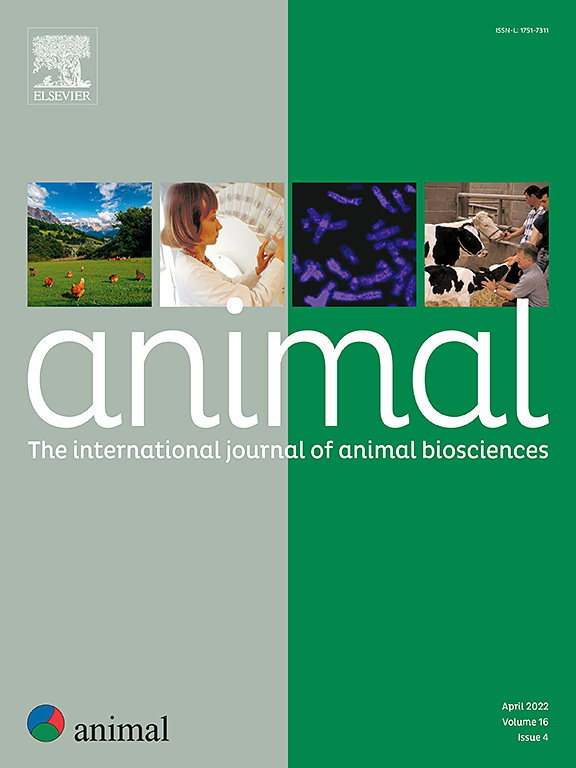现代速生和慢生肉鸡基因型的潜在气候性能
IF 4.2
2区 农林科学
Q1 AGRICULTURE, DAIRY & ANIMAL SCIENCE
引用次数: 0
摘要
以提高饲料效率为目的的遗传选择在减少畜牧业生产对环境的影响方面具有重要作用。本研究的目的是在满足育种公司设定的性能目标的条件下,量化各种现代快速生长和缓慢生长肉鸡基因型的全球变暖潜势。研究人员估计了全球变暖的可能性,这些鸟类分别被喂食传统和不含大豆的饮食,并摄入不同水平的均衡蛋白质。采用基于ISO 14040标准的生命周期评估方法对生产过程中产生的温室气体排放进行量化。结果表明,与生长最慢的基因型相比,生长最快的基因型在实现其生产性能目标时,其全球变暖潜能值最低,差异超过每公斤净膛胴体1公斤二氧化碳当量。由于更快的生长速度缩短了达到屠宰体重的时间(基因型之间从38天到61天不等),在整个生长周期中,每只鸡作为热量损失的能量减少了13兆焦耳,因此所需的饲料也减少了。饲料效率的提高是重要的,因为饲料相关排放对肉鸡总体温室气体排放的贡献很大,在传统的大豆饲粮中为88 - 92%。此外,身体组成的差异也对鸟类的能量消耗和相应的温室气体排放产生影响。饮食中的蛋白质来源通常具有较高的温室气体强度,因此在某些情况下,降低饮食中的蛋白质浓度可能会降低全球变暖的潜力。另一方面,由于对鸟类生长速度的不利影响,这种影响是有限的。在可以使用较低排放强度蛋白质源的情况下,降低饲粮中蛋白质浓度不会进一步改善肉鸡生产的气候性能。相反,在这种情况下,由于生长周期较长,低蛋白质饮食增加了排放量。综上所述,现代肉鸡基因型全球变暖潜势的差异与其饲料能量利用效率的差异有关。这种效率取决于鸟类的生长速度,尽管身体成分的差异也有一些影响。本文章由计算机程序翻译,如有差异,请以英文原文为准。
Potential climate performance of modern fast- and slow-growing broiler genotypes
Genetic selection aiming to improve the feed efficiency is believed to have a significant role in reducing the environmental impacts of livestock production. The aim of this study was to quantify the global warming potential of a wide range of modern fast−growing and slow−growing broiler genotypes under conditions where they are expected to meet their performance objectives set by breeding companies. The global warming potential was estimated for scenarios where the birds were fed on conventional and soy−free diets with different levels of balanced protein. Life cycle assessment approach based on the ISO 14040 standards was used to quantify the greenhouse gas emissions arising from the production. The results show that the fastest−growing genotypes have the lowest global warming potential when achieving their performance objectives, the difference being over 1 kg CO2e per kg eviscerated carcass, compared to the slowest−growing genotypes. As the faster growth rate reduces the time to reach the slaughter weight (ranging from 38 days to 61 days between the genotypes), up to 13 MJ less energy per bird is lost as heat during the whole growth cycle and therefore less feed is needed. The improvement of feed efficiency is important because the feed-related emissions have a high contribution to the overall greenhouse gas emissions of broilers, ranging from 88 – 92%, when fed with the traditional soya-based diet. Additionally, differences in the body composition also have an effect on the energy consumption of the birds and on the corresponding greenhouse gas emissions. The protein sources in diets have generally high greenhouse gas intensity, and therefore reducing the protein concentration of the diet may, in some cases, reduce the global warming potential. On the other hand, this effect is limited by the adverse effect on the growth rate of the birds. In cases where protein sources with lower emission intensity can be used, the reduction of the protein concentration in the diet does not bring any further improvement to the climate performance of broiler production. In contrast, in such cases, low protein diets increase the emissions as a result of the longer growth cycle. In conclusion, the differences in Global Warming Potential of modern broiler genotypes are related to the differences in their efficiency of the use of feed energy. This efficiency is dependent on the growth rate of the birds, although the differences in body composition also have some effect.
求助全文
通过发布文献求助,成功后即可免费获取论文全文。
去求助
来源期刊

Animal
农林科学-奶制品与动物科学
CiteScore
7.50
自引率
2.80%
发文量
246
审稿时长
3 months
期刊介绍:
Editorial board
animal attracts the best research in animal biology and animal systems from across the spectrum of the agricultural, biomedical, and environmental sciences. It is the central element in an exciting collaboration between the British Society of Animal Science (BSAS), Institut National de la Recherche Agronomique (INRA) and the European Federation of Animal Science (EAAP) and represents a merging of three scientific journals: Animal Science; Animal Research; Reproduction, Nutrition, Development. animal publishes original cutting-edge research, ''hot'' topics and horizon-scanning reviews on animal-related aspects of the life sciences at the molecular, cellular, organ, whole animal and production system levels. The main subject areas include: breeding and genetics; nutrition; physiology and functional biology of systems; behaviour, health and welfare; farming systems, environmental impact and climate change; product quality, human health and well-being. Animal models and papers dealing with the integration of research between these topics and their impact on the environment and people are particularly welcome.
 求助内容:
求助内容: 应助结果提醒方式:
应助结果提醒方式:


